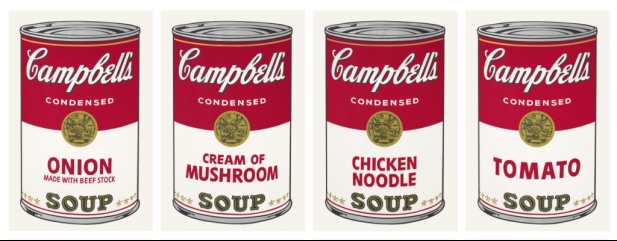Archived article
Please note that tax, investment, pension and ISA rules can change and the information and any views contained in this article may now be inaccurate.
Discover the ingredients behind the success of soups-to-cookies maker Campbell’s

Condensed and ready-to-serve soups, cookies and potato chips may not excite investors as much as cloud computing, electric vehicles or the hottest new fashion brands, but shares in storied US processed foods-to-snacks company Campbell Soup (CPB:NYSE) are up 20% year-to-date amid ravenous appetite for the dependable earnings delivered by consumer staples.
Historically, this $15.8 billion cap has outperformed the S&P 500 during downturns and with a global recession looming, the American packaged food group should prove resilient as consumers conserve cash by staying in to cook meals and wolf down snacks.
Investor appetite for dependable cash flows generated by a brand portfolio that has stood the test of time explains why Campbell Soup’s shares aren’t cheap.
They trade on 18.1 times forecast earnings for the year to July 2023 according to consensus data from Stockopedia, a rating that drops to 17.3 times based on 2024 estimates.
Prospective investors should also heed de-rating risk should inflationary cost pressures bite into margins and the cost-of-living crisis drive cash-strapped shoppers into the arms of cheaper private label competition.
UP CLOUSE & PERSONAL WITH CAMPBELL’S
New Jersey headquartered since 1869, present-day Campbell Soup is guided by CEO Mark Clouse, a former US army pilot and seasoned food industry executive. The company is most closely associated with its flagship canned soup products.
However, through mergers and acquisitions (M&A), the company has grown to become one of America’s largest processed food companies with a wide variety of products under the flagship Campbell’s brand, as well as other differentiated brands like Pepperidge Farm, Snyder’s of Hanover and Swanson.
Through its Meals & Beverages division, it makes Campbell’s condensed and ready-to-serve soups, Swanson broth and stocks as well as Pacific Foods broth, soups and non-dairy beverages, not to mention Prego pasta sauces, Campbell’s gravies and dinner sauces, Swanson chicken broth, V8 juices and beverages and Campbell’s tomato juice.
The Snacks division consists of Pepperidge Farm cookies, Goldfish crackers and Snyder’s of Hanover pretzels, as well as the likes of Cape Cod and Kettle Brand potato chips.
A CANNED HISTORY
For those who like their corporate history, Campbell Soup was founded by fruit merchant and namesake Joseph Campbell and commercial canner Abraham Anderson back in 1869 in New Jersey as Anderson & Campbell.
It claimed the name Campbell Soup Company during Dr. John T. Dorrance’s tenure as president in honour of his groundbreaking invention, condensed soup, which made soups more affordable for families whilst preserving ingredient quality.
The group’s first red and white soup can label made its debut in 1898 after a company executive attended the annual Cornell-Penn football game and was particularly taken with Cornell’s new red and white uniforms.
In 1922, the group adopted ‘Soup’ as its middle name and officially became Campbell Soup Company. The classic red-and-white can design used by many Campbell’s branded products has become an American icon and its use in pop art was typified by Andy Warhol’s series of Campbell’s Soup Cans prints.
HOW DOES CAMPBELL SOUP COMPARE TO KRAFT HEINZ?
Campbell Soup’s products vie for supermarket shelf space with a number of players. They include Kraft Heinz (KHC:NASDAQ), the Warren Buffett-backed maker of Heinz Soup, ketchup and baked beans, as well as HP Sauce, Philadelphia cream cheese and Oscar Mayer wieners, which readers may recall made a bold and unsuccessful tilt at Colman’s mustard-to-Marmite maker Unilever (ULVR) in 2017.
At $47.7 billion, Kraft Heinz’s market cap is more than three times larger than Campbell Soup’s, while annual revenue in the former’s last financial year of $26 billion was more than three times that of the latter’s fiscal 2022 sales of $8.6 billion, giving it considerable marketing clout.
But size isn’t everything, as Kraft Heinz is more lowly rated on a forward PE basis than Campbell Soup. Its shares trade on 14.4 times forecast earnings for 2022 with a prospective dividend yield of 4.1% versus a 2.9% forward yield for Campbell’s. This rating differential might reflect the fact that Kraft Heinz remains indebted and, due to its scale, is less agile than Campbell Soup.
Kraft Heinz’s legacy brands have also become a bit tired, or ‘a little bit dusty’ as CEO Miguel Patricio recently told CNN.
Investors are also worried about the threat of market share erosion at the expense of private label brands as inflationary pressures send grocery prices skyrocketing, though Campbell Soup arguably faces the same challenges.

IS CAMPBELL SOUP SERVING UP PORTFOLIO NOURISHMENT?
Thanks to its strong supply chain and the resilience of its brands – a staggering 95% of all American households have a Campbell brand in their home – the company dished out earnings per share (EPS) for the year to July 2022 at the high end of management’s original guidance range, no mean feat in one of the most volatile economic climates in living memory.
Net sales nudged up 6% to $2 billion in a strong fourth quarter and adjusted earnings before interest (EBIT) fattened up 5% to $269 million as Campbell Soup flexed its pricing power muscles and delivered cost savings, with the market shares of most of its key brands remaining at or above full year 2019 (so pre-pandemic) levels.
Following this tasty finish to the year, and in a show of confidence in continued elevated demand for its brands, Campbell Soup guided towards full year 2023 organic sales growth of 4% to 6%, with Clouse and co expecting to stir up sales growth in both the group’s divisions.
‘During fiscal 2022, we demonstrated a significant step up in execution across the company with improved supply chain performance and effective revenue management to counter inflation,’ explained Clouse. ‘Our solid foundation and momentum will serve us well in fiscal 2023 as we continue to make progress on unlocking Campbell’s full growth potential.’
Income-hungry investors will note Campbell Soup is also a cash flow star turn. It churned out $1.2 billion of free cash flow from operations last year, of which more than $600 million was returned to shareholders through dividends and share buybacks.
FUTURE-PROOFING CAMPBELL SOUP
Now in its third century, the iconic brand is also embracing technology to ensure it survives to see a fourth by growing its product portfolio, using artificial intelligence to spot new trends and expanding beyond its soupy roots with the help of acquisitions.
In 2017, Campbell Soup bought Pacific Foods, a maker of organic soups, broths, and milks. The following year, it munched on snacks giant Snyder’s-Lance, which owns Late July, Pop Secret and other brands.
And while health-conscious millennials may turn their noses up at its condensed soups, the company’s recent product innovations include Oat milk-based soups, which the company rolled out in 2021 through Pacific Foods, as well as FlavorUp, a cooking concentrate that comes in three flavours.
Last but not least, Campbell Soup recently inked a 12-year virtual renewable power purchase agreement with Enel North America to support the soup maker’s goals of reducing greenhouse gas emissions. Those interested in the story and an update on progress should put Campbell Soup’s first quarter results date (7 December) in the diary.

Important information:
These articles are provided by Shares magazine which is published by AJ Bell Media, a part of AJ Bell. Shares is not written by AJ Bell.
Shares is provided for your general information and use and is not a personal recommendation to invest. It is not intended to be relied upon by you in making or not making any investment decisions. The investments referred to in these articles will not be suitable for all investors. If in doubt please seek appropriate independent financial advice.
Investors acting on the information in these articles do so at their own risk and AJ Bell Media and its staff do not accept liability for losses suffered by investors as a result of their investment decisions.
Issue contents
Feature
Great Ideas
News
- New life sciences investment company seeks to take advantage of depressed UK valuations
- Find out what China’s protests and latest Covid plans mean for stocks
- Why no-frills Costco Wholesale continues to flourish
- Retail sector breathes sigh of relief as Black Friday sales top expectations
- Card Factory bucks the negative retail sector trend with share price surge
- Shares in Home REIT are down hard on short-selling report

 magazine
magazine








